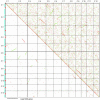Ancient polyploidization predating divergence of the cereals, and its consequences for comparative genomics
- PMID: 15161969
- PMCID: PMC470771
- DOI: 10.1073/pnas.0307901101
Ancient polyploidization predating divergence of the cereals, and its consequences for comparative genomics
Abstract
Integration of structural genomic data from a largely assembled rice genome sequence, with phylogenetic analysis of sequence samples for many other taxa, suggests that a polyploidization event occurred approximately 70 million years ago, before the divergence of the major cereals from one another but after the divergence of the Poales from the Liliales and Zingiberales. Ancient polyploidization and subsequent "diploidization" (loss) of many duplicated gene copies has thus shaped the genomes of all Poaceae cereal, forage, and biomass crops. The Poaceae appear to have evolved as separate lineages for approximately 50 million years, or two-thirds of the time since the duplication event. Chromosomes that are predicted to be homoeologs resulting from this ancient duplication event account for a disproportionate share of incongruent loci found by comparison of the rice sequence to a detailed sorghum sequence-tagged site-based genetic map. Differential gene loss during diploidization may have contributed many of these incongruities. Such predicted homoeologs also account for a disproportionate share of duplicated sorghum loci, further supporting the hypothesis that the polyploidization event was common to sorghum and rice. Comparative gene orders along paleo-homoeologous chromosomal segments provide a means to make phylogenetic inferences about chromosome structural rearrangements that differentiate among the grasses. Superimposition of the timing of major duplication events on taxonomic relationships leads to improved understanding of comparative gene orders, enhancing the value of data from botanical models for crop improvement and for further exploration of genomic biodiversity. Additional ancient duplication events probably remain to be discovered in other angiosperm lineages.
Figures



References
-
- Vision, T., Brown, D. & Tanksley, S. (2000) Science 290, 2114-2117. - PubMed
Publication types
MeSH terms
LinkOut - more resources
Full Text Sources
Other Literature Sources

